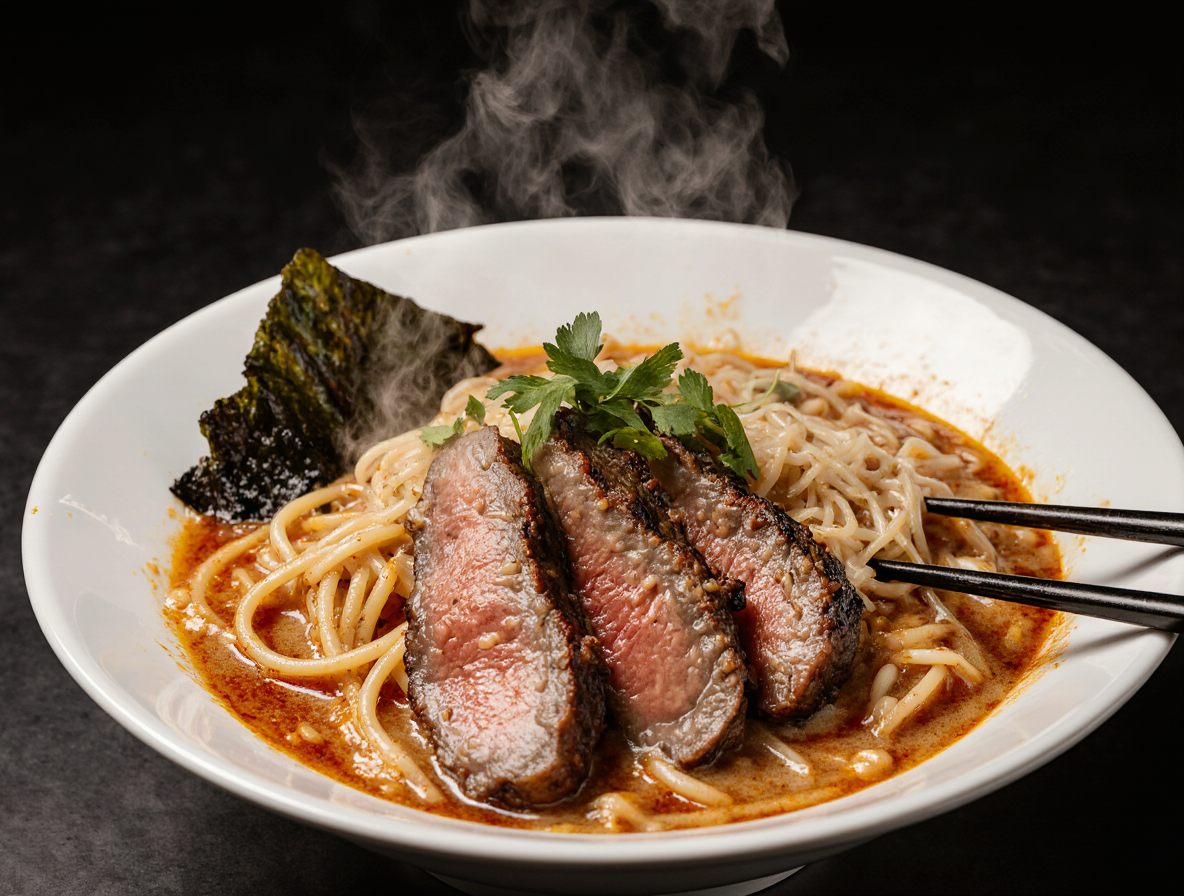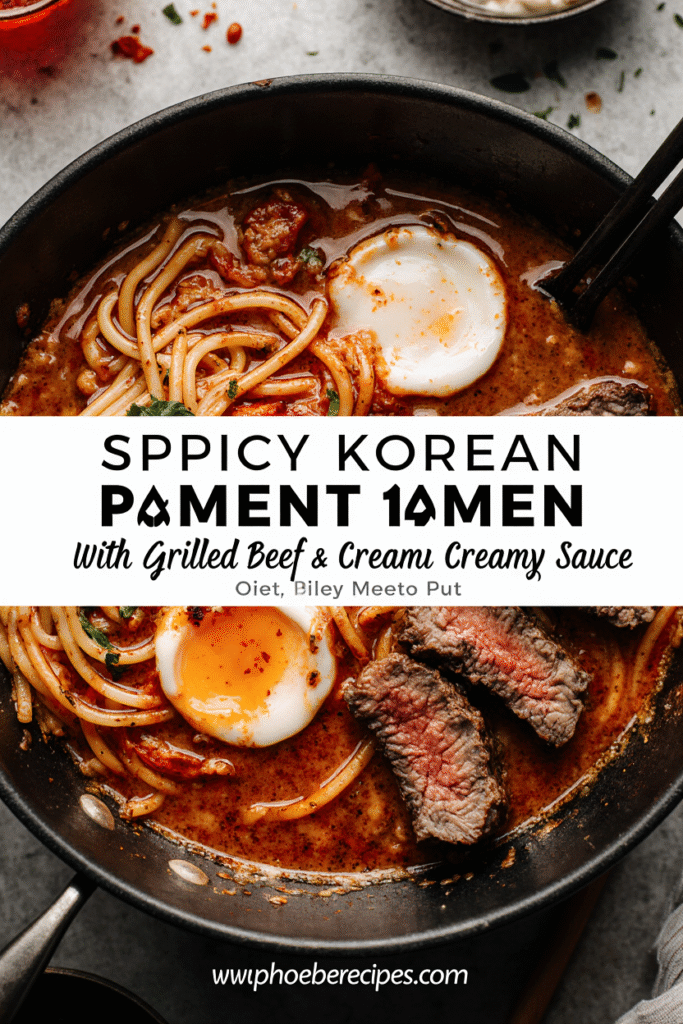The Secret to Restaurant-Worthy Korean Beef Ramen at Home [Easy Guide]
Korean beef ramen transforms instant noodles into a gourmet meal that rivals restaurant dishes. Surprisingly, this flavorful upgrade takes less than 30 minutes from prep to table, making it perfect for busy weeknights when we crave something delicious without the hassle.
As a longtime fan of korean noodle dishes, I’ve discovered that spicy korean beef ramen offers impressive nutritional value alongside its bold flavors. A typical bowl contains approximately 680-787 calories, with a balanced 34g of protein and 34g of fat – certainly enough to satisfy hunger while delivering the comfort we crave from noodle dishes. Furthermore, this korean beef ramen recipe is incredibly versatile and family-friendly, allowing us to adjust spice levels and ingredients based on preference.
In this guide, I’ll walk you through the exact steps to create restaurant-worthy korean spicy beef noodles at home. From selecting the perfect cut of beef to mastering that creamy or spicy sauce, we’ll cover everything you need to know to make korean beef ramen recipes that will impress family and friends alike.
Choosing the Right Ingredients for Korean Beef Ramen
The secret to creating authentic Korean beef ramen begins with selecting premium ingredients. Initially, understanding which components contribute to that distinctive Korean flavor profile will help you replicate restaurant-quality results at home.
Best cuts of beef for ramen
For Korean beef ramen recipes, the right cut makes all the difference in texture and flavor. Rib eye stands as the premier choice due to its ideal balance of tenderness and fat content. Flank steak or brisket, thinly sliced, provide excellent alternatives that cook quickly while maintaining tenderness. For those seeking maximum flavor in broth-based versions, collagen-rich short ribs or oxtails create exceptional depth and body as they simmer. Tenderloin works wonderfully for those preferring leaner options or when cooking for elderly family members who appreciate softer textures.
Recommended Korean ramen brands
Among Korean instant ramyun options, Nongshim Shin Ramyun reigns supreme as the preferred base for homemade creations. Paldo Gomtang offers an excellent non-spicy alternative that closely mimics traditional seollungtang (Korean ox-bone soup) with its rich, beefy profile and thinner noodles. Nongshim Ansungtangmyun and Ottugi Jin Ramen also enjoy popularity among Korean ramyun enthusiasts. Notably, when possible, purchase authentic Korean-market versions rather than those packaged for American markets to experience true Korean flavors.
Essential sauces and seasonings
The distinctive taste of Korean beef ramen derives from key seasoning components:
Gochujang (Korean chili paste) delivers the foundational spicy-sweet flavor unique to Korean cuisine. This fermented paste creates depth impossible to substitute.
Sesame oil qualifies as perhaps the most essential pantry ingredient in Korean cooking—particularly toasted varieties that instantly elevate any dish with their nutty aroma.
Other critical elements include garlic, ginger, soy sauce (or tamari for gluten-free options), rice vinegar, and brown sugar for balance. Advanced cooks might explore specialty items like Nongshim’s Beef Dasida Stock or Gochugaru (Korean chili flakes) for authentic depth.
Optional toppings for extra flavor
Fresh toppings transform basic ramen into something special:
- Eggs: Medium-boiled or soft-boiled with jammy yolks that enrich the broth
- Vegetables: Thinly sliced green onions/scallions, mushrooms (particularly hon-shimeji), kimchi, and sliced cucumbers
- Garnishes: Toasted sesame seeds, seaweed, and fresh herbs
Additionally, adding a splash of milk creates creamier textures that complement spicy broths beautifully. For optimal results, slightly undercook your noodles initially—they’ll reach perfect consistency just as you begin eating, avoiding the soggy texture that comes from overcooking.
Step-by-Step: How to Make Korean Beef Ramen at Home
Creating authentic Korean beef ramen at home is simpler than you might expect. In fact, with these straightforward steps, you’ll be enjoying restaurant-quality noodles in less than 30 minutes.
1. Marinate the beef
Start by slicing your beef thinly across the grain—ribeye works excellently, though sirloin or flank steak are fantastic alternatives. In a bowl, combine gochujang, soy sauce, sesame oil, rice vinegar, sugar, and chopped green onions. Pour half of this mixture over your beef, ensuring each piece is coated. For optimal flavor, marinate for at least 30 minutes, though overnight delivers even better results.
2. Prepare the creamy or spicy sauce
For spicy sauce, reserve the remaining marinade mixture from step one. For a creamier option, combine chicken stock with unsweetened soy milk (2:1 ratio), then add gochujang, white sesame paste (or smooth peanut butter), chili oil, and vinegar. Alternatively, create a tomato-based cream sauce by sautéing garlic and tomato paste in butter until it deepens in color, subsequently adding ginger, hoisin, oyster sauce, soy sauce, and heavy cream.
3. Cook the noodles properly
Bring a pot of water to boil and cook your ramen noodles according to package instructions—typically 2-3 minutes. The secret to perfect texture: cook until the noodles just separate, then immediately drain and rinse under cold water to stop the cooking process. This prevents sogginess and creates that ideal chewy texture.
4. Sear or grill the beef
Heat a skillet over medium-high heat with a drizzle of oil. Once hot, add the marinated beef in a single layer without overcrowding. Cook for 2-3 minutes per side until nicely browned. Remove the beef and set aside to rest briefly before slicing thinly.
5. Assemble and garnish the bowl
Divide your noodles between bowls, then pour your prepared sauce over them. Arrange your beautifully seared beef on top, followed by your choice of garnishes—soft-boiled eggs, mushrooms, sliced scallions, baby bok choy, or sliced cucumber. Finish with a sprinkle of sesame seeds and optional drizzle of chili oil.
Customizing Your Korean Noodle Dish
One of the joys of Korean beef ramen lies in its endless adaptability to personal preferences. Beyond the basic recipe, customizing your bowl transforms it into a unique creation that matches your dietary needs and flavor preferences.
Protein swaps: chicken, tofu, or pork
While beef creates rich flavor, alternative proteins offer variety. Rotisserie chicken provides convenience with 27 grams of protein per 100 grams, making it perfect for quick meals. Simply shred it, toss in chili oil, and place atop your noodles. Lean pulled pork delivers equal protein content while maintaining the traditional ramen experience. For plant-based options, firm tofu (8 grams of protein per 100 grams) or tempeh (19 grams of protein per 100 grams) work beautifully—the latter offering a nutty texture that complements chewy noodles.
Vegetable add-ins for texture and nutrition
Quick-cooking vegetables elevate both nutrition and presentation:
- Baby spinach, romaine lettuce, bean sprouts, thinly sliced cabbage
- Longer-cooking vegetables like broccoli, cauliflower, snap peas
- Frozen vegetables such as corn and peas
Moreover, mushrooms—particularly shiitake—add meaty texture when sautéed with garlic and soy sauce.
Adjusting spice levels to your taste
Taming excessive heat becomes simple with strategic additions. Milk effectively moderates spiciness while creating creaminess. Cheese offers another approach—simply laying slices over hot ramen instantly reduces heat while adding flavor. Alternatively, sweeteners like honey or sugar help balance intense spice. For those seeking more fire, combining gochujang, chili paste, sriracha, and hot sauce creates extraordinary heat.
Making it gluten-free or dairy-free
For gluten-free versions, substitute wheat noodles with rice noodles or tofu noodles. Ensure you use tamari instead of soy sauce. Dairy-free alternatives include unsweetened soy milk, almond milk, or coconut milk. Essentially, these substitutions maintain authentic flavors while accommodating dietary restrictions. Silken tofu adds creaminess to dairy-free versions, while nutritional yeast can replace cheese’s umami quality.
Storage, Reheating, and Meal Prep Tips
Properly storing leftover korean beef ramen can make the difference between a soggy disappointment and a meal that tastes nearly as good as when freshly made. With the right techniques, you can enjoy your korean noodle dishes days after preparation.
How to store noodles and beef separately
First and foremost, always separate the components before refrigeration. Store the noodles and broth in different airtight containers. This prevents the noodles from absorbing too much liquid and becoming mushy. For optimal texture, drizzle the noodles with a small amount of sesame oil and toss to coat before storing. Your beef components can be stored alongside the noodles, while the broth should be kept separate. These properly stored leftovers will remain fresh for 3-4 days in the refrigerator.
Reheating without losing texture
Beyond simple storage, reheating requires special attention. For best results, reheat only the broth until it’s boiling hot, then pour it over the cold noodles. This method prevents overcooking while ensuring the noodles warm through quickly. If using the stovetop, bring the broth to a boil, stirring occasionally. For microwave reheating, warm the broth in 60-second intervals, stirring between each until piping hot. Remember that freezing noodles isn’t recommended as they’ll turn soggy upon thawing.
Make-ahead components for busy nights
Fortunately, many elements of spicy korean beef ramen can be prepared in advance. The beef can be marinated and cooked up to three days ahead. Prep vegetables by chopping mushrooms, grating ginger, mincing garlic, and slicing green onions, then store in separate containers. The broth itself can be partially made up to five days in advance – simply hold back the pork, bok choy, and green onions until reheating. Even boiled eggs can be prepared three days ahead. During assembly, ensure the broth is boiling hot before pouring over cold noodles for perfect temperature balance.
Conclusion
Korean beef ramen stands out as a perfect balance of convenience, flavor, and versatility. Throughout this guide, we’ve seen how ordinary instant noodles transform into extraordinary meals with just a few thoughtful additions and techniques.
Making restaurant-quality Korean beef ramen at home certainly doesn’t require professional culinary skills. Instead, success comes from understanding a few key principles: selecting the right beef cut, choosing quality ramen brands, mastering the perfect sauce, and cooking noodles properly.
Additionally, the adaptability of this dish makes it perfect for almost any dietary preference. Vegetarians can swap beef for tofu, spice lovers can amp up the heat with extra gochujang, while those with dietary restrictions can easily find gluten-free or dairy-free alternatives without sacrificing flavor.
Perhaps most importantly, Korean beef ramen fits perfectly into busy lifestyles. The entire dish comes together in under 30 minutes, though you can also prep components ahead of time for even quicker assembly on hectic weeknights.
Finally, don’t feel intimidated by trying something new. Korean beef ramen welcomes experimentation – each bowl becomes a canvas for your culinary creativity. Whether you prefer your ramen mild or fiery, loaded with vegetables or focused on protein, this versatile dish adapts to your preferences while delivering that satisfying, comforting experience we all crave from a good bowl of noodles.
Now that you understand the fundamentals, your next delicious Korean beef ramen creation awaits. Grab your chopsticks, gather your ingredients, and get ready to enjoy restaurant-worthy ramen without leaving home!
FAQs
Q1. What are the key ingredients for making Korean beef ramen at home? The essential ingredients include quality beef (like ribeye or flank steak), Korean ramen noodles, gochujang (Korean chili paste), sesame oil, soy sauce, garlic, and ginger. Optional toppings like eggs, green onions, and mushrooms can enhance the flavor.
Q2. How long does it take to prepare Korean beef ramen? Korean beef ramen can be prepared in less than 30 minutes, making it an ideal choice for a quick and delicious weeknight dinner. However, marinating the beef for at least 30 minutes or overnight can improve the flavor.
Q3. Can I make Korean beef ramen vegetarian or vegan? Yes, you can easily adapt Korean beef ramen for vegetarian or vegan diets. Replace the beef with firm tofu or tempeh, and use vegetable broth instead of beef broth. Ensure to use tamari instead of soy sauce for a gluten-free option.
Q4. How can I adjust the spice level of my Korean beef ramen? To reduce spiciness, add milk or cheese to create a creamier texture that balances the heat. For those who prefer more heat, combine gochujang, chili paste, sriracha, and hot sauce. You can also add sweeteners like honey to balance intense spice.
Q5. What’s the best way to store and reheat leftover Korean beef ramen? Store the noodles, beef, and broth separately in airtight containers in the refrigerator for up to 3-4 days. When reheating, heat only the broth until boiling, then pour it over the cold noodles and beef. This method prevents overcooking and maintains the best texture.


